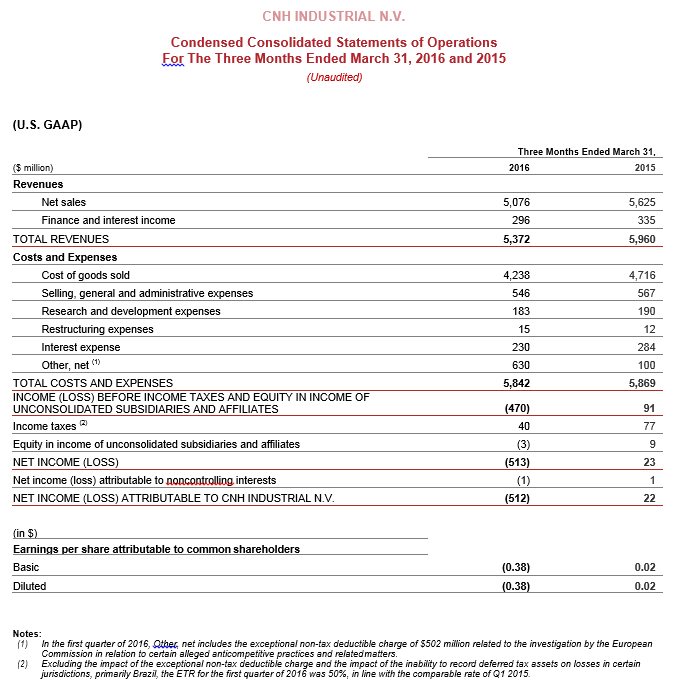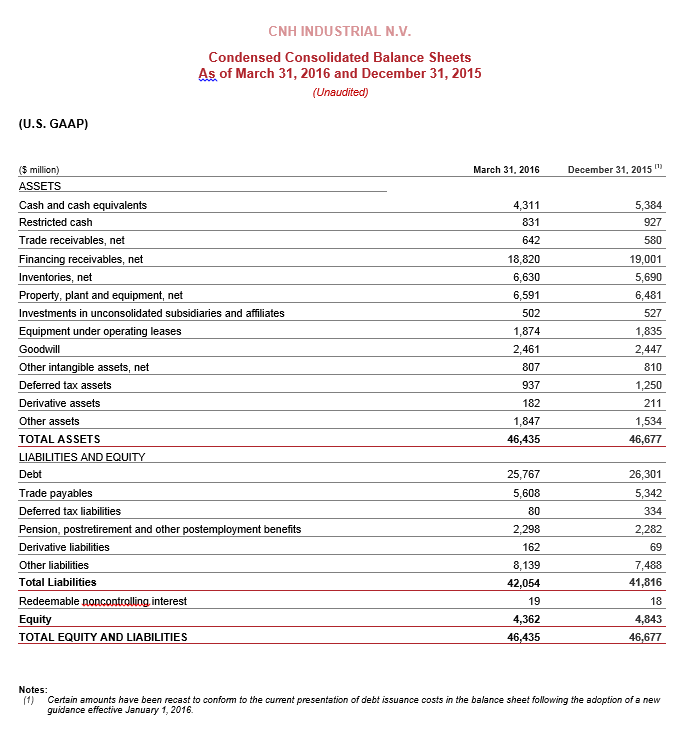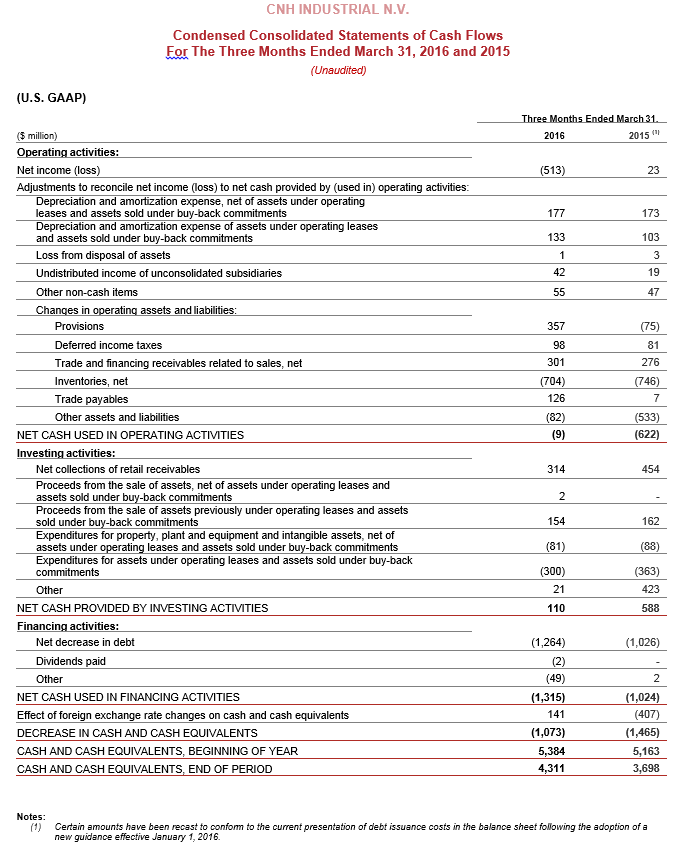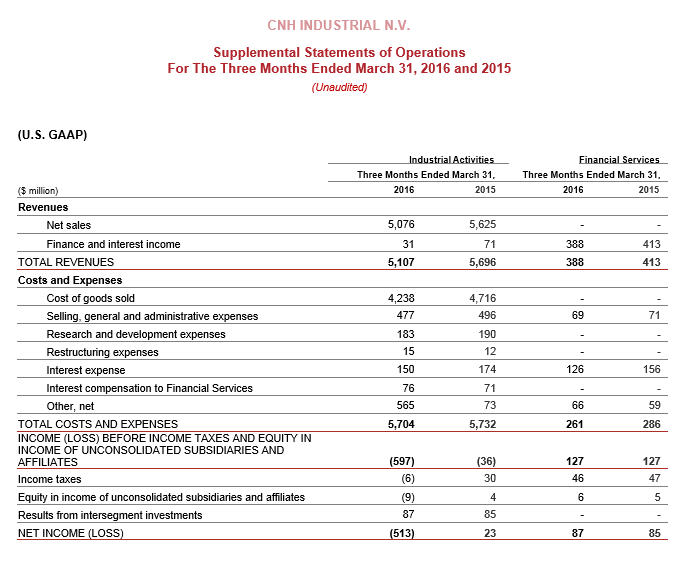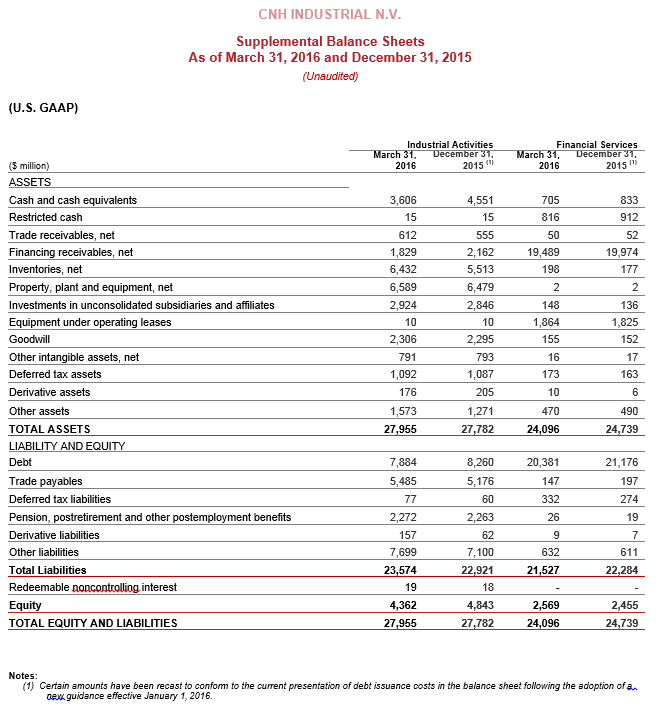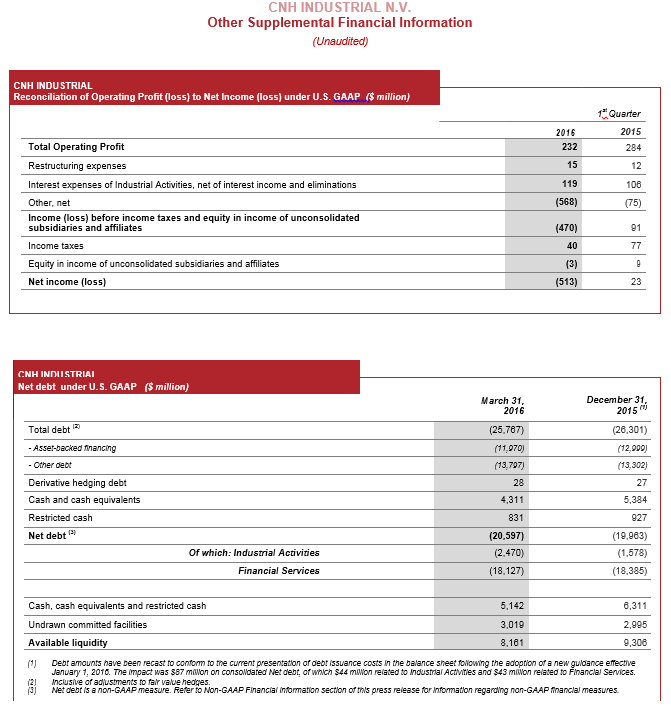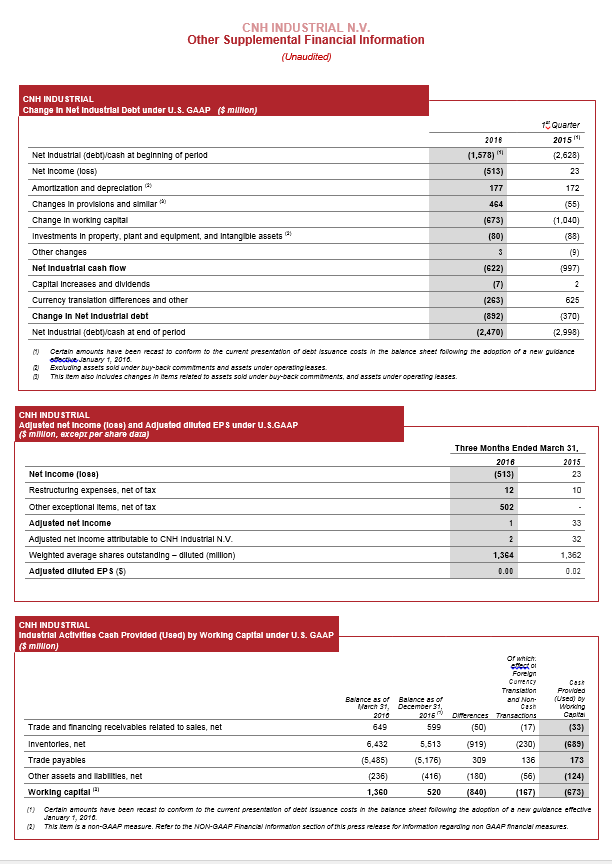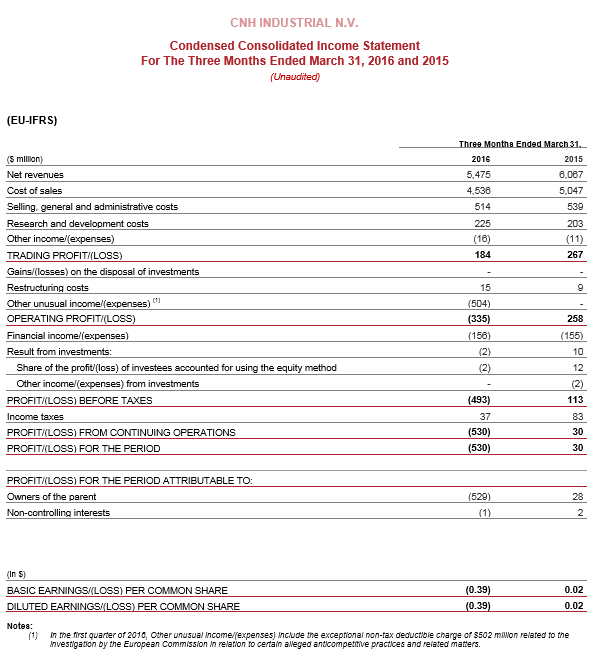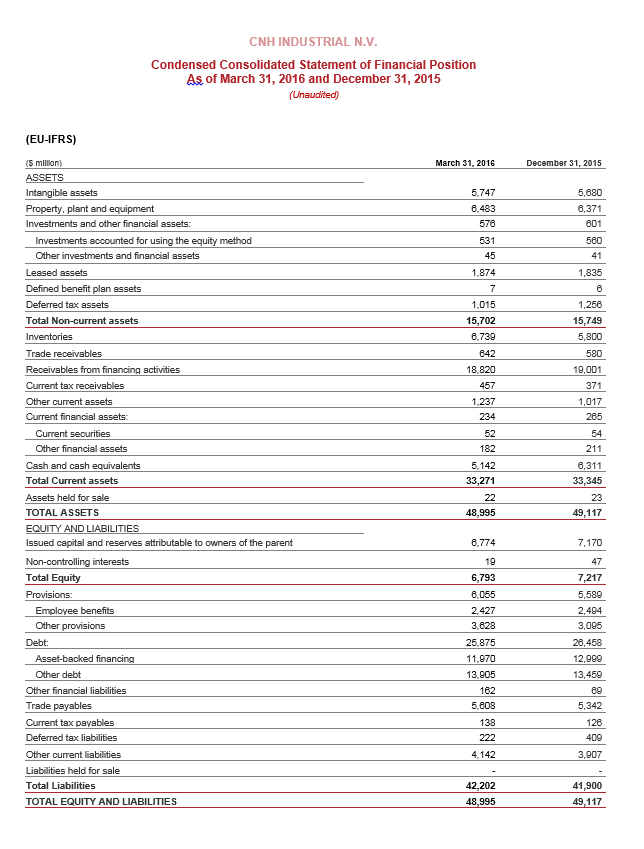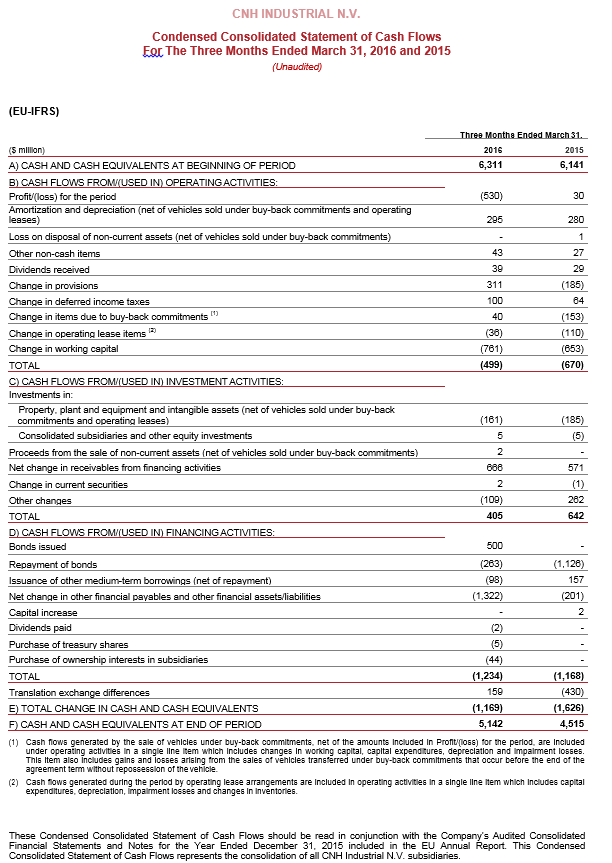London (UK) – (April 29, 2016) CNH Industrial N.V. (NYSE:CNHI / MI:CNHI) today announced consolidated revenues of $5,372 million for the first quarter 2016, down 5.7% compared to the first quarter 2015 on a constant currency basis (down 9.9% on a reported basis). Net sales of Industrial Activities were $5,076 million in Q1 2016, down 5.7% compared to the same period in 2015 on a constant currency basis (down 9.8% on a reported basis). Operating profit of Industrial Activities was $178 million for the first quarter, a $45 million decrease compared to the same period in 2015, with an operating margin of 3.5%, down 0.5 p.p. compared to the first quarter 2015. “Given market conditions, we are pleased with the performance of our operating segments this quarter,” said Richard Tobin, Chief Executive Officer of CNH Industrial. “While we continue to navigate challenging trading conditions in the agricultural equipment industry, we are encouraged by the improved operating profits and margins in our other industrial segments compared to last year.”
Net loss was $513 million for the quarter, or -$0.38 per share, after recording the previously announced exceptional non-tax deductible charge of $502 million related to the investigation of the Company’s wholly- owned subsidiary, Iveco S.p.A., and its competitors by the European Commission for certain alleged anticompetitive practices and related matters. Adjusted net income, which excludes this exceptional charge and restructuring expenses, was $1 million for the quarter.
Given the losses in certain jurisdictions and the inability to book the related tax benefit, the Company recorded a tax charge in excess of its long-term effective tax rate (“ETR”) objective of between 34% to 36%. Net industrial debt of $2.5 billion at March 31, 2016, was $0.9 billion higher than at December 31, 2015, including a $0.2 billion negative foreign exchange translation impact. Net industrial cash flow was a net outflow of $0.6 billion in the first quarter 2016, a $0.4 billion improvement over the same period last year. As of March 31, 2016, available liquidity was $8.2 billion, up $1.0 billion compared to March 31, 2015.
net sales decreased 13.6% for the first quarter 2016 compared to the same period in 2015 on a constant currency basis, as a result of unfavorable industry volume and product mix in the row crop sector in NAFTA and the Brazilian market in LATAM. Net sales increased in EMEA and APAC, mainly driven by favorable volume in Australia. Operating profit was $90 million for the first quarter ($204 million in the first quarter 2015). Operating margin decreased 3.7 p.p. to 4.2%, mainly due to unfavorable volume, industrial absorption and product mix in NAFTA and LATAM, partially offset by disciplined pricing and lower material costs.
net sales decreased 8.1% for the first quarter 2016 compared to the same period in 2015 on a constant currency basis, due to negative volume and mix primarily in NAFTA and LATAM. Operating profit was $14 million for the first quarter 2016, a $14 million increase compared to Q1 2015, with an operating margin of 2.6%. Construction Equipment’s operating profit increased as a result of improved margins in NAFTA and APAC more than offsetting the negative effects of challenging trading conditions in LATAM.
net sales increased 5.3% for the first quarter 2016 compared to the same period in 2015 on a constant currency basis, primarily as a result of favorable truck volume in EMEA. In LATAM, net sales decreased 52.6% due to lower industry volumes in Brazil and Argentina. In APAC, net sales decreased, mainly for buses. Operating profit was $38 million for the first quarter (operating margin of 1.9%). This represents a $37 million increase compared to Q1 2015, or a $49 million increase excluding the $12 million operating profit of our Venezuelan subsidiary recorded in Q1 2015 before the currency re-measurement in the second half of 2015. The increase was a result of improved volume and mix, positive pricing across all regions, and lower product costs. In EMEA, the increase was mainly due to favorable volume in trucks and buses. In LATAM, operating profit was flat as cost containment actions offset the effect of lower volumes due to market declines. In APAC, operating profit was positive due to truck pricing offsetting lower bus volumes.
net sales increased slightly in the first quarter 2016 compared to the same period in 2015 on a constant currency basis. Sales to external customers accounted for 44% of total net sales (47% in Q1 2015). Operating profit was $53 million for the first quarter, a $17 million increase compared to the first quarter 2015, with an operating margin of 6.0%, up 2.0 p.p. over the same period in 2015. The improvement was mainly due to positive product mix and industrial efficiencies.
revenues totaled $388 million in the first quarter 2016, flat compared to the first quarter 2015 on a constant currency basis. In the first quarter 2016, retail loan originations (including unconsolidated joint ventures) were $1.9 billion, down $0.1 billion compared to the first quarter 2015 on a constant currency basis, primarily due to the decline in Agricultural Equipment sales. The managed portfolio (including unconsolidated joint ventures) of $24.9 billion as of March 31, 2016 (of which retail was 65% and wholesale 35%) was down $0.6 billion compared to December 31, 2015 on a constant currency basis, primarily in NAFTA and EMEA.
Net income was $87 million for the first quarter 2016, an increase of $2 million over the same period in 2015, with improved net interest margin more than offsetting slightly higher provision for credit losses and the negative impact of currency translation.
2016 Outlook
Trading conditions in Agricultural Equipment continue to remain challenging particularly in the row crop industry in NAFTA and in LATAM, while EMEA agricultural equipment markets are expected to be flat. The commercial vehicles industry is expected to increase between 5% and 10% in EMEA; trading conditions in LATAM are expected to remain challenging. CNH Industrial is confirming its 2016 guidance as follows:
• Net sales of Industrial Activities between $23 billion and $24 billion, with an operating margin of Industrial Activities between 5.2% and 5.8%;
• Net industrial debt at the end of 2016 between $1.5 billion and $1.8 billion, excluding any potential cash payment as a result of the European Commission investigation and related matters.
About CNH Industrial
CNH Industrial N.V. (NYSE: CNHI /MI: CNHI) is a global leader in the capital goods sector with established industrial experience, a wide range of products and a worldwide presence. Each of the individual brands belonging to the Company is a major international force in its specific industrial sector: Case IH, New Holland Agriculture and Steyr for tractors and agricultural machinery; Case and New Holland Construction for earth moving equipment; Iveco for commercial vehicles; Iveco Bus and Heuliez Bus for buses and coaches; Iveco Astra for quarry and construction vehicles; Magirus for firefighting vehicles; Iveco Defence Vehicles for defence and civil protection; and FPT Industrial for engines and transmissions. More information can be found on the corporate website: www.cnhindustrial.com
Additional Information
Today, at 3:30 p.m. CEST / 2:30 p.m. BST / 9:30 a.m. EDT, management will hold a conference call to present 2016 first quarter results to financial analysts and institutional investors. The call can be followed live online at: http://bit.ly/CNH_Industrial_Q1_2016 and a recording will be available later on the Company’s website (www.cnhindustrial.com). A presentation will be made available on the CNH Industrial website prior to the call.
Non-GAAP Financial Information
CNH Industrial monitors its operations through the use of several non-GAAP financial measures. CNH Industrial believes that these non-GAAP financial measures provide useful and relevant information regarding its results and enhance the reader’s ability to assess CNH Industrial’s financial performance and financial position. They provide measures which facilitate management’s ability to identify operational trends, as well as make decisions regarding future spending, resource allocations and other operational decisions. These and similar measures are widely used in the industries in which the Company operates. These financial measures may not be comparable to other similarly titled measures used by other companies and are not intended to be substitutes for measures of financial performance and financial position prepared in accordance with U.S. GAAP and/or EU-IFRS.
CNH Industrial non-GAAP financial measures are defined as follows:
•
Operating Profit under U.S. GAAP: Operating Profit of Industrial Activities is defined as net sales less cost of goods sold, selling, general and administrative expenses, and research and development expenses. Operating Profit
of Financial Services is defined as revenues less selling, general and administrative expense, interest expenses and certain other operating expenses.
•
Trading Profit under EU-IFRS: Trading Profit is derived from financial information prepared in accordance with EU-IFRS and is defined as income before restructuring, gains/(losses) on disposal of investments and other
unusual items, interest expense of Industrial Activities, income taxes, equity in income (loss) of unconsolidated subsidiaries and affiliates, non-controlling interests.
•
Operating Profit under EU-IFRS: Operating Profit under EU-IFRS is computed starting from Trading Profit under EU- IFRS plus/minus restructuring costs, other income (expenses) that are unusual in the ordinary course of
business (such as gains and losses on the disposal of investments and other unusual items arising from infrequent external events or market conditions).
• Adjusted Net Income (Loss): is defined as net income (loss), less restructuring charges and exceptional items, after tax.
•
Adjusted Diluted EPS: is computed by dividing Adjusted Net Income (loss) attributable to CNH Industrial N.V. by a weighted-average number of common shares outstanding during the period that takes into consideration
potential common shares outstanding deriving from the CNH Industrial share-based payment awards, when inclusion is not anti- dilutive.
•
Net Debt and Net Debt of Industrial Activities (or Net Industrial Debt): CNH Industrial provides the reconciliation of Net Debt to Total Debt, which is the most directly comparable measure included in the consolidated balance
sheets. Due to different sources of
cash flows used for the repayment of the debt between Industrial Activities and Financial Services (by cash from operations for Industrial Activities and by collection of financing receivables
for Financial Services), management separately evaluates the cash flow
performance of Industrial Activities using Net Debt of Industrial Activities.
•
Working Capital: is defined as trade receivables and financing receivables related to sales, net, plus inventories, less trade payables, plus other assets (liabilities), net.
•
Constant Currency: CNH Industrial discusses the fluctuations in revenues and certain non-GAAP financial measures on a constant currency basis by applying the prior year exchange rates to current year’s values expressed in
local currency in order to eliminate
the impact of foreign exchange rate fluctuations.
Forward-looking statements
All statements other than statements of historical fact contained in this earning release including statements regarding our competitive strengths; business strategy; future financial position or operating results; budgets; projections with respect to revenue, income, earnings (or loss) per share, capital expenditures, dividends, capital structure or other financial items; costs; and plans and objectives of management regarding operations and products, are forward-looking statements. These statements may include terminology such as “may”, “will”, “expect”, “could”, “should”, “intend”, “estimate”, “anticipate”, “believe”, “outlook”, “continue”, “remain”, “on track”, “design”, “target”, “objective”, “goal”, “forecast”, “projection”, “prospects”, “plan”, or similar terminology. Forward-looking statements are not guarantees of future performance. Rather, they are based on current views and assumptions and involve known and unknown risks, uncertainties and other factors, many of which are outside our control and are difficult to predict. If any of these risks and uncertainties materialize or other assumptions underlying any of the forward-looking statements prove to be incorrect, the actual results or developments may differ materially from any future results or developments expressed or implied by the forward-looking statements. Factors, risks and uncertainties that could cause actual results to differ materially from those contemplated by the forward-looking statements include, among others: the many interrelated factors that affect consumer confidence and worldwide demand for capital goods and capital goods-related products; general economic conditions in each of our markets; changes in government policies regarding banking, monetary and fiscal policies; legislation, particularly relating to capital goods-related issues such as agriculture, the environment, debt relief and subsidy program policies, trade and commerce and infrastructure development; government policies on international trade and investment, including sanctions, import quotas, capital controls and tariffs; actions of competitors in the various industries in which we compete; development and use of new technologies and technological difficulties; the interpretation of, or adoption of new, compliance requirements with respect to engine emissions, safety or other aspects of our products; production difficulties, including capacity and supply constraints and excess inventory levels; labor relations; interest rates and currency exchange rates; inflation and deflation; energy prices; prices for agricultural commodities; housing starts and other construction activity; our ability to obtain financing or to refinance existing debt; a decline in the price of used vehicles; the resolution of pending litigation and investigations on a wide range of topics, including dealer and supplier litigation, intellectual property rights disputes, product warranty and defective product claims, and emissions and/or fuel economy regulatory and contractual issues; the evolution of our contractual relations with Kobelco Construction Machinery Co., Ltd. and Sumitomo (S.H.I.) Construction Machinery Co., Ltd.; our pension plans and other post-employment obligations; political and civil unrest; volatility and deterioration of capital and financial markets, including further deterioration of the Eurozone sovereign debt crisis, other similar risks and uncertainties and our success in managing the risks involved in the foregoing. Further information concerning factors, risks, and uncertainties that could materially affect the Company’s financial results is included in our annual report on Form 20-F for the year ended December 31, 2015, prepared in accordance with U.S. GAAP and in our EU Annual Report at December 31, 2015, prepared in accordance with EU-IFRS. Investors should refer to and consider the incorporated information on risks, factors, and uncertainties in addition to the information presented here.
Forward-looking statements speak only as of the date on which such statements are made. Furthermore, in light of ongoing difficult macroeconomic conditions, both globally and in the industries in which we operate, it is particularly difficult to forecast our results and any estimates or forecasts of particular periods that we provide in this earnings release are uncertain. Accordingly, investors should not place undue reliance on such forward-looking statements. We can give no assurance that the expectations reflected in our forward-looking statements will prove to be correct. Our outlook is based upon assumptions relating to the factors described in the earnings release, which are sometimes based upon estimates and data received from third parties. Such estimates and data are often revised. Our actual results could differ materially from those anticipated in such forward-looking statements. We undertake no obligation to update or revise publicly our outlook or forward-looking statements. Further information concerning CNH Industrial and its businesses, including factors that potentially could materially affect CNH Industrial’s financial results, is included in CNH Industrial’s reports and filings with the U.S. Securities and Exchange Commission (“SEC”), the Autoriteit Financiële Markten (“AFM”) and Commissione Nazionale per le Società e la Borsa (“CONSOB”).
All future written and oral forward-looking statements by CNH Industrial or persons acting on the behalf of CNH Industrial are expressly qualified in their entirety by the cautionary statements contained herein or referred to above.
(1) CNH Industrial reports quarterly and annual consolidated financial results under U.S. GAAP and EU-IFRS. The tables and discussion related to the financial results of the Company and its segments shown in this press release are prepared in accordance with U.S. GAAP. Financial results under EU-IFRS are shown in specific tables at the end of this press release.
(2) Refer to the Non-GAAP Financial Information section of this press release for information regarding Non-GAAP financial measures.
Contacts
Media Inquiries
United Kingdom
Richard Gadeslli
Tel: +44 207 7660 346
Laura Overall
Tel: +44 207 7660 346
Italy
Francesco Polsinelli
Tel: +3 335 1776 091
Cristina Formica
Tel: +39 011 0062 464
Email: mediarelations@cnhind.com
www.cnhindustrial.com
Investor Relations
Federico Donati
Tel: +44 207 7660 386
Noah Weiss
Tel: +1 630 887 3745
